Ixeris chinensis (Thunb.) Nakai is the whole herb of Sonchus of the family Asteraceae (1). According to the textual research on the herbal literature, the authentic source of Chinese herbal medicine bitter vegetables should be the main stream of Sonchus oleraceus L, which belongs to Sonchus, Ixeris polycephala Cass of Ixeris Cass, and the dried whole grass of Chinese Ixeris (2). I. chinensis is a traditional medicinal plant, which can be used to treat tumors, inflammation and some infections. I. chinensis contains a variety of flavonoids, which have various pharmacological or health effects such as antioxidant, anti-cancer, antihypertensive, improving cardiovascular diseases, lowering blood lipids, lowering cholesterol, and protecting our liver (3). I. chinensis is one of the traditional Chinese herbs in China, with a wide range of distribution, easy survival and a wide variety of species (4).
In recent years, with the deepening of the research on I. chinensis, the clinical application scope of the herb has been continuously expanded (5). It is often used in combination with other Chinese medicines for treating various inflammatory diseases such as gastritis, enteritis, lung fever and cough, sore throat, etc. (6). The pharmacological effects of I. chinensis have been studied more extensively, but the mechanism of action of the disease is still unknown and needs to be studied thoroughly.
Network pharmacology research uses public databases and literature to screen out the target information of known drug components (7). Then uses network visualization tools to build a multi-dimensional biological network model, through multi-level analysis of specific signal nodes in the network at the cellular, molecular and overall biological levels, to identify key nodes, and from the perspective of the overall biological network balance to discover the target drug’s interference with the “pathogenic network,” and then predicts the pharmacological active ingredients, targets and possible involvement in the regulation of cellular signal transduction pathways, potential pharmacological mechanisms and formulation and combination patterns of known drugs to combat diseases (8). To predict the active ingredients, targets, cellular signal transduction pathways, potential pharmacological mechanisms and prescriptions that may be involved in the regulation of known drugs against diseases (9). Finally, validation at the animal or cellular level, will reveal the modern pharmacological mechanisms of drugs against diseases and explore new indications for drug interventions (10).
This artical adopted the research method of network pharmacology. By screening the active components and key targets of I. chinensis, we systematically analyzed its potential action targets to construct protein interaction networks and the enriched biological processes and pathways, so as to elaborate the pharmacological action mechanism of I. chinensis, which laid a foundation for further in-depth study on the mechanism of action of I. chinensis in the treatment of specific diseases and was of great significance in the field of new drug development.
2 Materials and methods 2.1 DatabaseTraditional Chinese Medicine Systems Pharmacology (TCMSP), HERB database, Pubchem database, Swiss Target Prediction database, Uniprot database, STRING database, DAVID database, pubmed, Web of Science, China National Knowledge Infrastructure (CNKI), Wangfang database.
2.2 Composition softwareCytoscape3.9.1, Rstudio, Microlife Letter, PyMOL, AutoDockTools, RevMan 5.4.1.
2.3 Screening of monomeric active compounds in Chinese medicineBy searching the Traditional Chinese Medicine Systems Pharmacology Database and Analysis Platform. The results were obtained by searching for “Sonchus oleraceus L,” “Ixeris polycephala Cass,” “I. chinensis (Thunb.) Nakai,” “Lactuca tatarica.” The active ingredients were searched in the HERB database by searching for “I. chinensis.”
2.4 Target screening of active compoundsWe inputted the active components of I. chinensis into the swiss target prediction to predict the target genes, and used the Uniprot database (see foot note 5) to convert the full name of the target gene to the abbreviation, deleted the target without corresponding gene name, and used Cytoscape 3.9.1 to construct the network diagram of I. chinensis – component-target.
2.5 Critical targets screeningThe potential targets were entered into the STRING database for protein interaction analysis, free targets were excluded, and the Protein–protein interaction (PPI) network was constructed using Cytoscape 3.9.1 software to screen for key targets, which could be considered as important proteins for bittercress to exert its medicinal effects.
2.6 Enrichment analysisWe used the DAVID database to perform Gene Ontology (GO) analysis and Kyoto Encyclopedia of Genes and Genomes (KEGG) pathway enrichment analysis on key targets, including Biological Process (BP), Cell Component (CC) and Molecular Function (MF). With human gene as the background, set p-value<0.01, we screened the top 10 BP, CC, MF entries and the top 20 KEGG pathway entries, and used the microbiota website to make enrichment histogram and bubble chart.
2.7 Prediction of target diseasesWe used the Rstudio software to analyze DO data, and used the microbiota website for visual analysis. According to the p-value, we screened the top 20 target diseases with the highest credibility, so as to achieve the effect of disease prediction.
2.8 Molecular docking technologyAccording to the PPI analysis results, we selected the top ten key targets AKT1, TNF, EGFR, ESR1, SRC, PTGS2, MAPK1, MMP9, IL2 and AR for docking. Based on the comprehensive analysis of the results of “component-target network” and “component- target-disease network,” the key components in I. chinensis luteolin, apigenin, chinensiolide c, chinensiolide b, chinensiolide a, β-sitosterol, luteolin-7-O-β-D-glucoside played a leading role in the network. We adopted semi flexible docking to find the best binding position and strength of substrate molecules and receptor molecules (11). We searched the 3D structure of key proteins in the PDB protein structure database, and selected the proteins with high resolution and long structure in the human background. PyMOL software was used to remove water and solvent molecules in the protein, and AutoDockTools 1.5.7 software was used to conduct hydrogenation treatment, set as ligand. After downloading the 3D structure of small molecules using Pubchem, swiss target prediction, hydrogenation was performed in AutoDockTools 1.5.7 software to automatically assign charges, set up as ligands and set up torsional bonds. We docked large and small molecules, set docking boxes, docked parameters and arithmetic methods. The screened macromolecules and small molecules from I. chinensis were docked separately, and the binding energy less than 0 indicated that the ligand and the receptor could bind spontaneously, the binding energy ≤ −5. 0 kcal·mol −1 proved that the component was well docked with the target site, and the binding energy ≤ −7. 0 kcal·mol −1 indicated that the component and the binding conformation of the target was strongly active (12). The docking results were thermographed using Rstudio, and those with high binding energy were visualized using PyMOL.
2.9 Meta analysis 2.9.1 Research typeRandomized controlled trial (RCT) of I. chinensis water extract in the treatment of diseases.
2.9.2 Research objectsMice fed with high-fat diet or injected with ccl4 and successfully modeled.
2.9.3 Intervention measuresTest group treated rats with I. chinensis water extract. The control group used placebo or no special treatment.
2.9.4 Outcome indicatorsTotal Cholesterol (TC), Triglycerides (TG), High-Density Lipoprotein Cholesterol (HDL-C), Low-Density Lipoprotein Cholesterol (LDL-C), Malondialdehyde (MDA).
2.9.5 Literature retrieval strategySubject term retrieval (see footnote 8), Web of Science (see footnote 9), CNKI (see footnote 10), Wanfang database (Wanfang, see footnote 11), to be included in the randomized controlled trial with I. chinensis as the treatment method. Take Pubmed as an example. See the table for its specific retrieval strategy (Table 1).
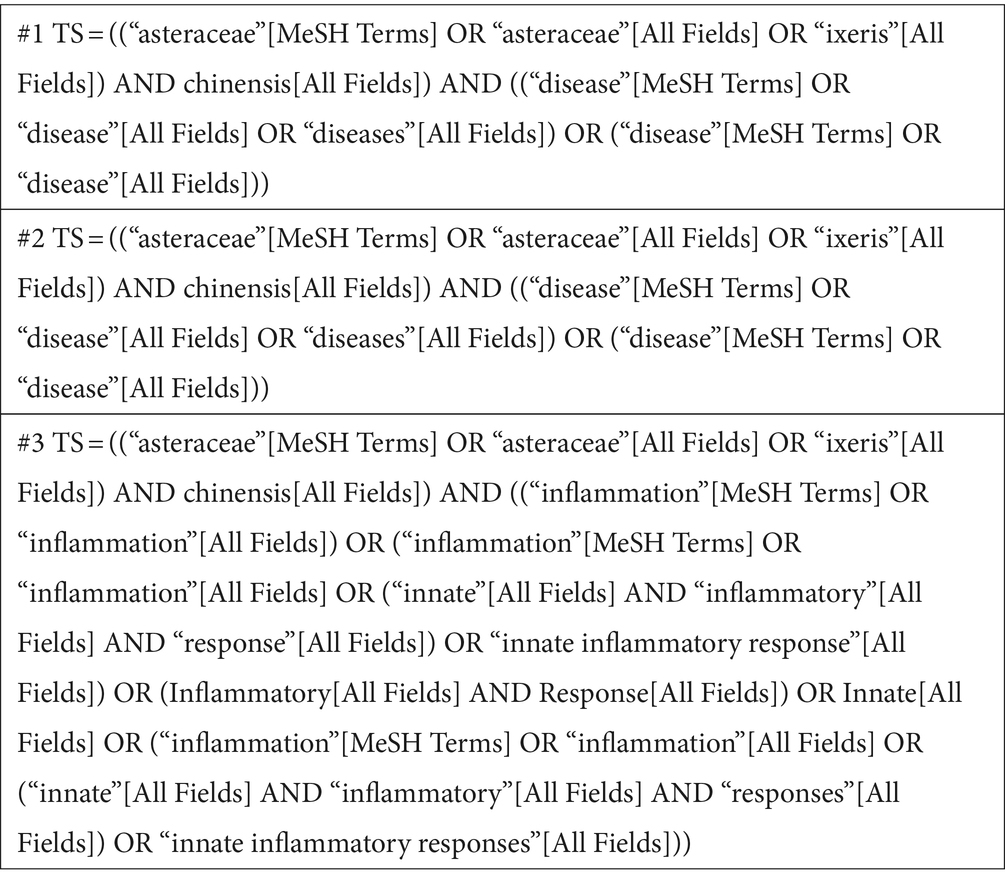
Table 1. Pubmed retrieval strategy.
2.9.6 For literature quality evaluationCochrane risk bias assessment tool and SYRCLE bias risk assessment tool were used to evaluate the quality of the included studies. The evaluation contents included: ① Random sequence generation (selection bias) ② Allocation consideration (selection bias), ③ Blinding of participants and persons (performance bias), ④ Blinding of outcome assessment (detection bias), ⑤ Incomplete outcome data (attribute bias), ⑥ Selective reporting (reporting bias), ⑦ Other biases.
2.9.7 Statistical analysisRevMan 5.4.1 software was used for meta analysis. The standardized mean difference (SMD) was used as the effect index for the measurement data. The point estimates and 95% CI were given for each effect. If p ≥ 0.1 and I2 < 50%, it was considered that the heterogeneity between the studies was not significant, and the fixed effect model was selected; If p < 0.1, I2 ≥ 50%, it was considered that there was significant heterogeneity among the studies, and the random effect model was selected (13).
3 Results 3.1 Screening for active compounds of I. chinensisWe searched the HERB database for “I. chinensi” and found that there were 12 active ingredients, namely Apigenin, β-sitosterol, calcium carbonate, chinensiolide a, chinensiolide b, chinensiolide c, ixerisosidea, ixerochinolide, ixerochinoside, Lactucin, Luteolin, luteolin-7-O-β-D-glucoside. The above active ingredients were used as research subjects.
3.2 Analysis of I. chinensis–active compound–target networkSince there was no match between the targets of HERB database and the active ingredients of I. chinensis, so we entered into Pubchem for searching, and the smileIDs of 10 active ingredients were obtained and then entered into Swiss Target Prediction for target gene prediction, among which the remaining two ingredients, “Lactucin” was used for target gene prediction in TCMSP website and “calcium carbonate” was used for target gene prediction in National Library of Medicine website. By screening the target genes with confidence greater than 0.01 or the top 15 target classes, converting the full names of target genes to abbreviations with the help of Uniprot database (see footnote 5) and deleting the targets without corresponding gene names, a total of 238 targets were derived, and using Cytoscape 3.9.1 to construct the I. chinensis–active compound–target network (Figure 1).

Figure 1. Ixeris chinensis active ingredient-target network diagram. The diamond shape represented the active ingredients of this herb, the oval represented the target site.
3.3 Key targets predictionAfter entering 238 potential targets into STRING database for protein interaction analysis and eliminating free targets, we used Cytoscape 3.9.1 software to construct PPI network (Figure 2) and calculated parameter thresholds, screened Degree (node centrality, reflecting the number of other targets that participate in different disease pathological processes together with a certain target) greater than 30, BC (mediator centrality value, the target with high proximity centrality was directly connected to more targets, indicating the importance of the target in different disease pathomechanical processes) was greater than 369, CC (closeness centrality, reflecting the proximity between a node and other nodes in the network) was greater than 0.0017, a total of 40 key targets were screened, which could be regarded as important proteins for I. chinensis to exert their medicinal effects (Table 2).
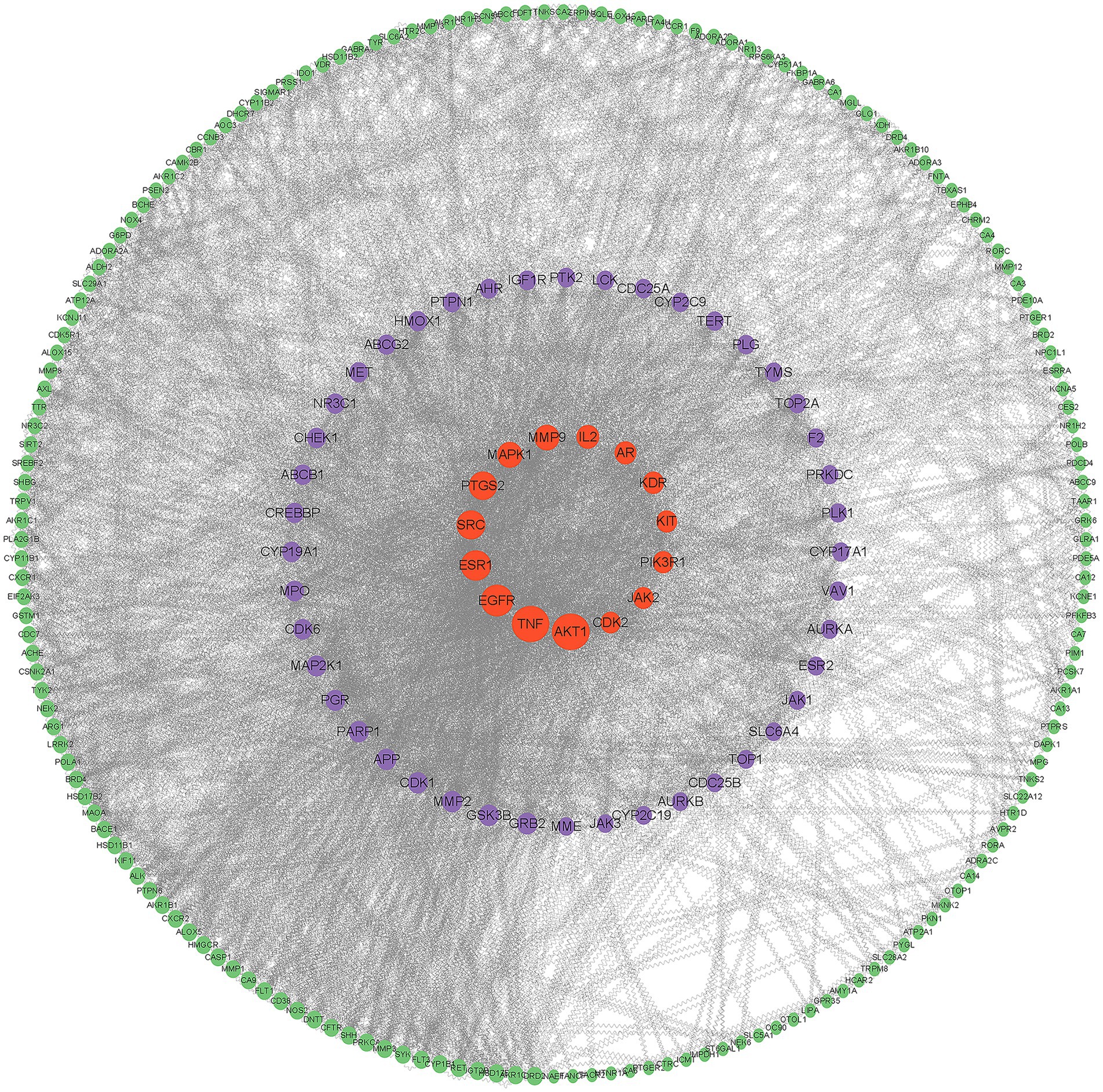
Figure 2. PPI network diagram. The larger the node shape in the figure and the closer to the center, the higher the criticality.
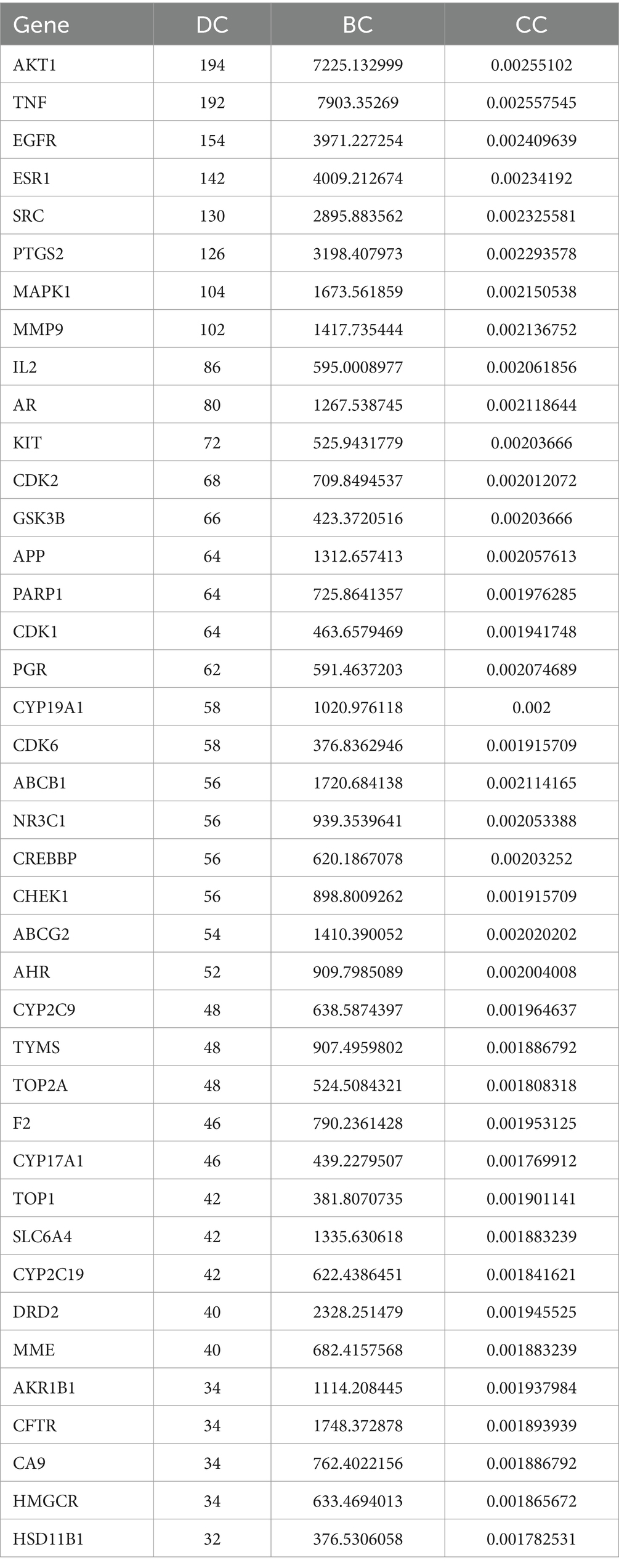
Table 2. Key targets prediction.
3.4 GO enrichment analysis of targetsGO-BP analysis showed that 225 biological processes were related to this, and the most significant top 5 were positive regulation of transcription from RNA polymerase II promoter, signal transduction, response to xenobiotic stimulus, positive regulation of gene expression, positive regulation of transcription, DNA-templated (Table 3). GO-CC analysis revealed 39 cellular compositions associated with this, the five most significant being cytoplasm, nucleoplasm, plasma membrane, nucleus, cytosol (Table 4). GO-MF analysis showed that 65 molecular functions were related to this, and the most significant 5 were protein binding, ATP binding, identical protein binding, enzyme binding, protein homodimerization (Table 5). The results suggested that I. chinensis could exert their therapeutic effects by participating in the regulation of various biological processes (Figure 3).

Table 3. GO-BP analysis.
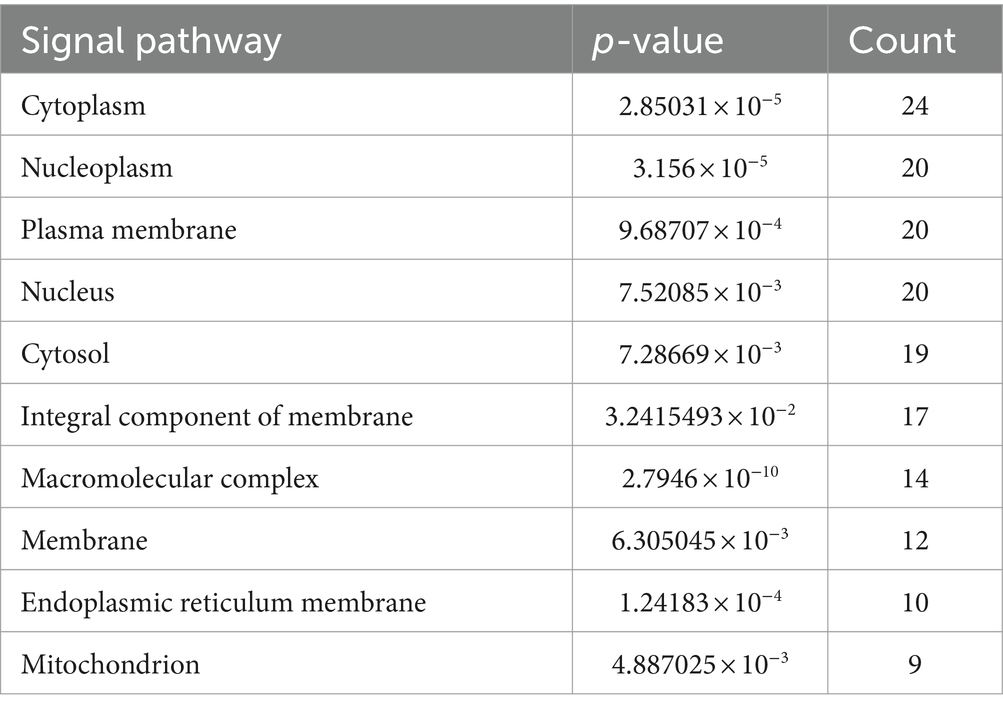
Table 4. GO-CC analysis.
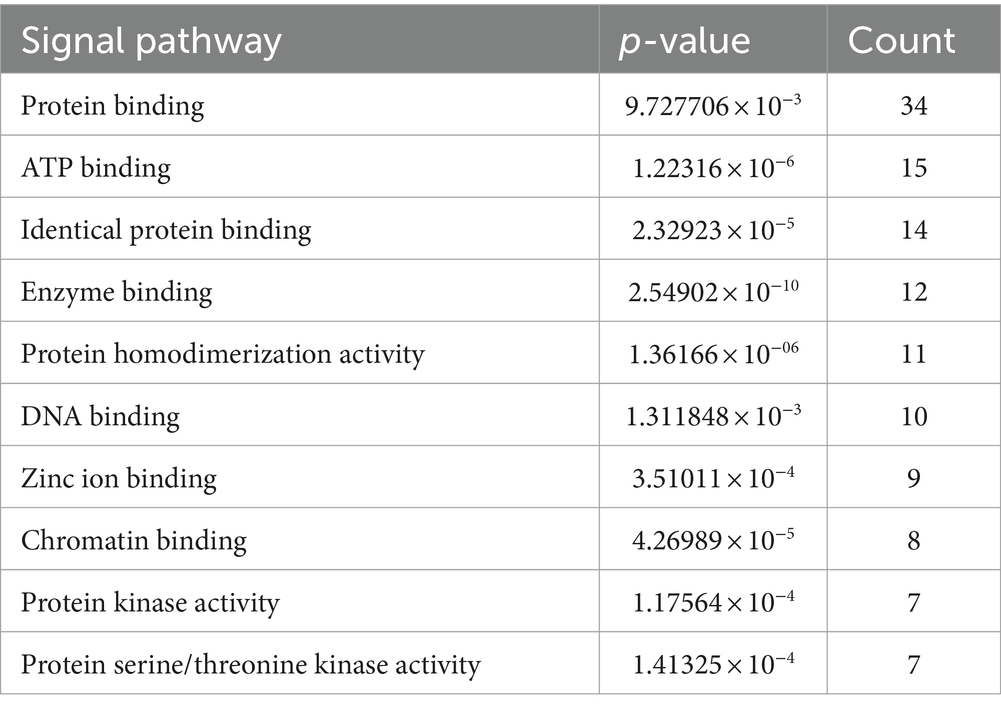
Table 5. GO-MF analysis.
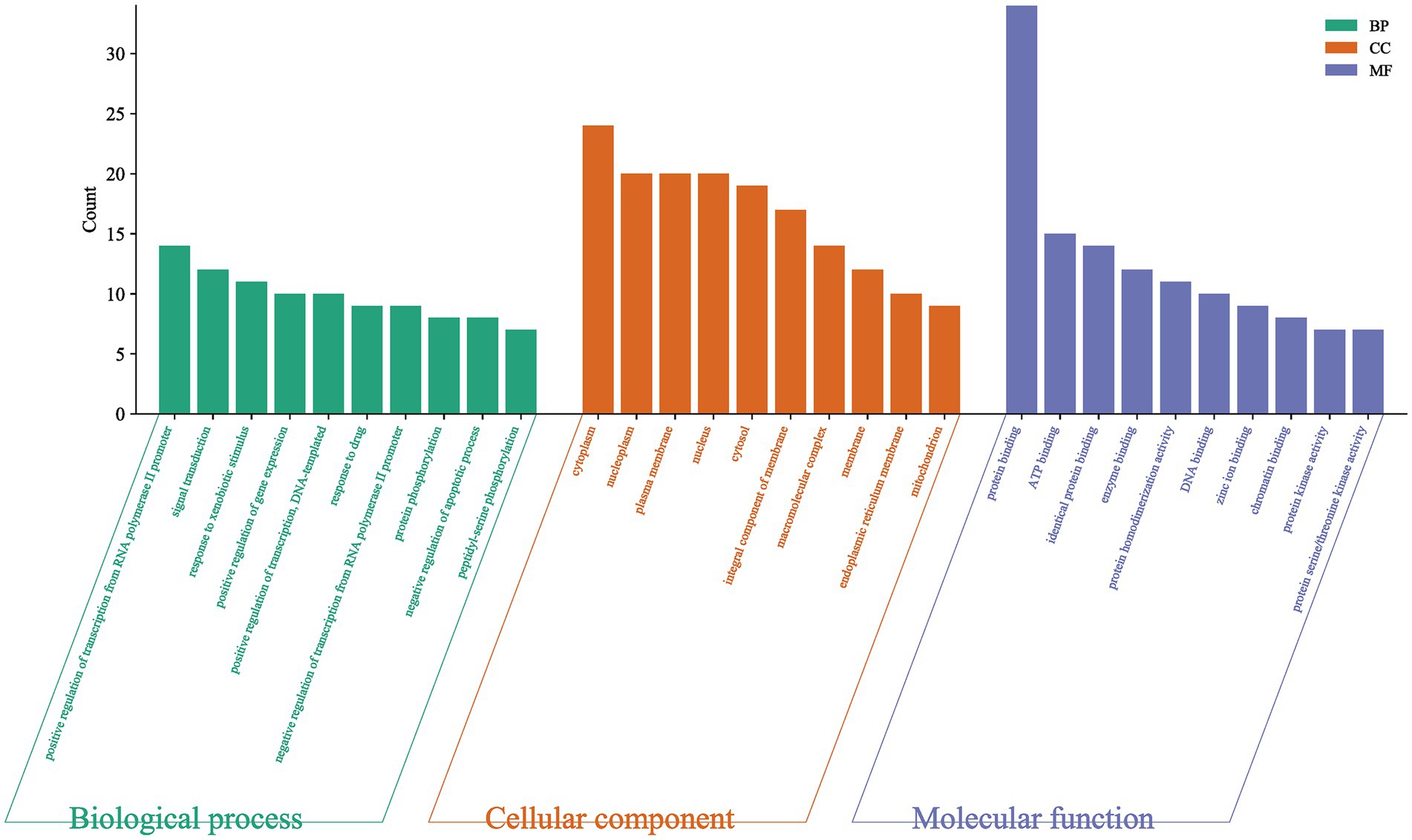
Figure 3. GO enrichment analysis results of key target proteins. Including biological process, cellular components, molecular functions.
3.5 Analysis of KEGG enrichment pathwayKEGG is the main database for systematic analysis of gene function, genomic and proteomic information, where different proteins exercise their biological behaviors in coordination with each other, and it helps researchers to study protein and expression information as a whole network. Included in the database are illustrated cellular biochemical processes such as metabolism, membrane transport, signaling, cell cycle, and also information on homologous conserved subpathways (14).
KEGG analysis showed that the five most significantly enriched pathways were Pathways in cancer, Human papillomavirus infection, Prostate cancer, Breast cancer, Chemical carcinogenesis-receptor activation (Table 6 and Figure 4). Among the pathways associated with disease classes, the main ones are the Pathways in cancer, Human papillomavirus infection, Prostate cancer, Breast cancer, Chemical carcinogenesis – receptor activation, Human cytomegalovirus infection, Cushing syndrome, Hepatitis C, Hepatitis B, Kaposi sarcoma-associated herpesvirus infection, Viral carcinogenesis, Proteoglycans in cancer, Lipid and atherosclerosis, Human T-cell leukemia virus 1 infection, MicroRNAs in cancer, Alzheimer disease, etc. Among the pathways associated with signaling functions were PI3K-Akt signaling pathway, Estrogen signaling pathway, Prolactin signaling pathway, etc. It was suggested that the potential targets were involved in multiple signaling pathways acting in concert.
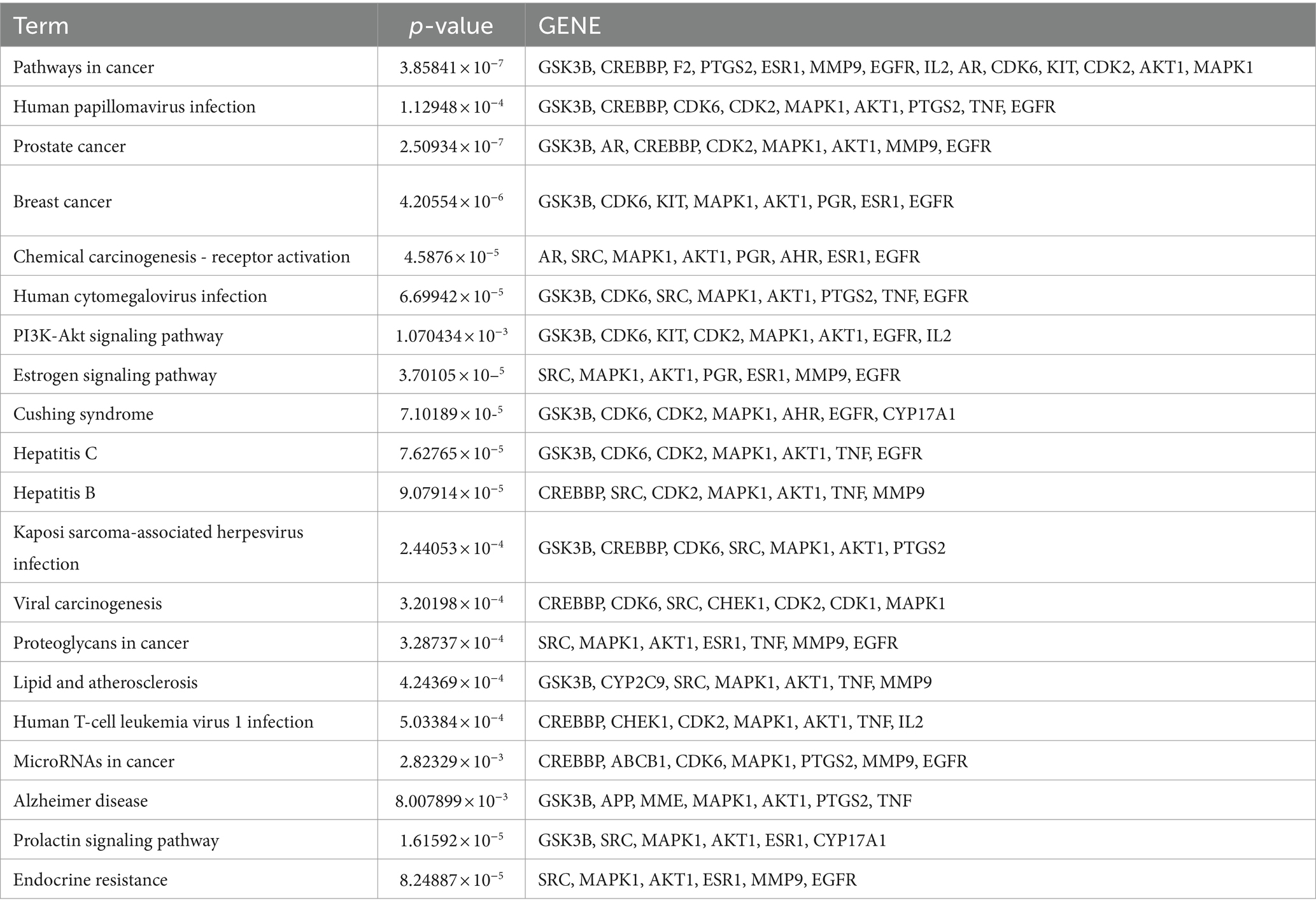
Table 6. Key target protein KEGG enrichment results.
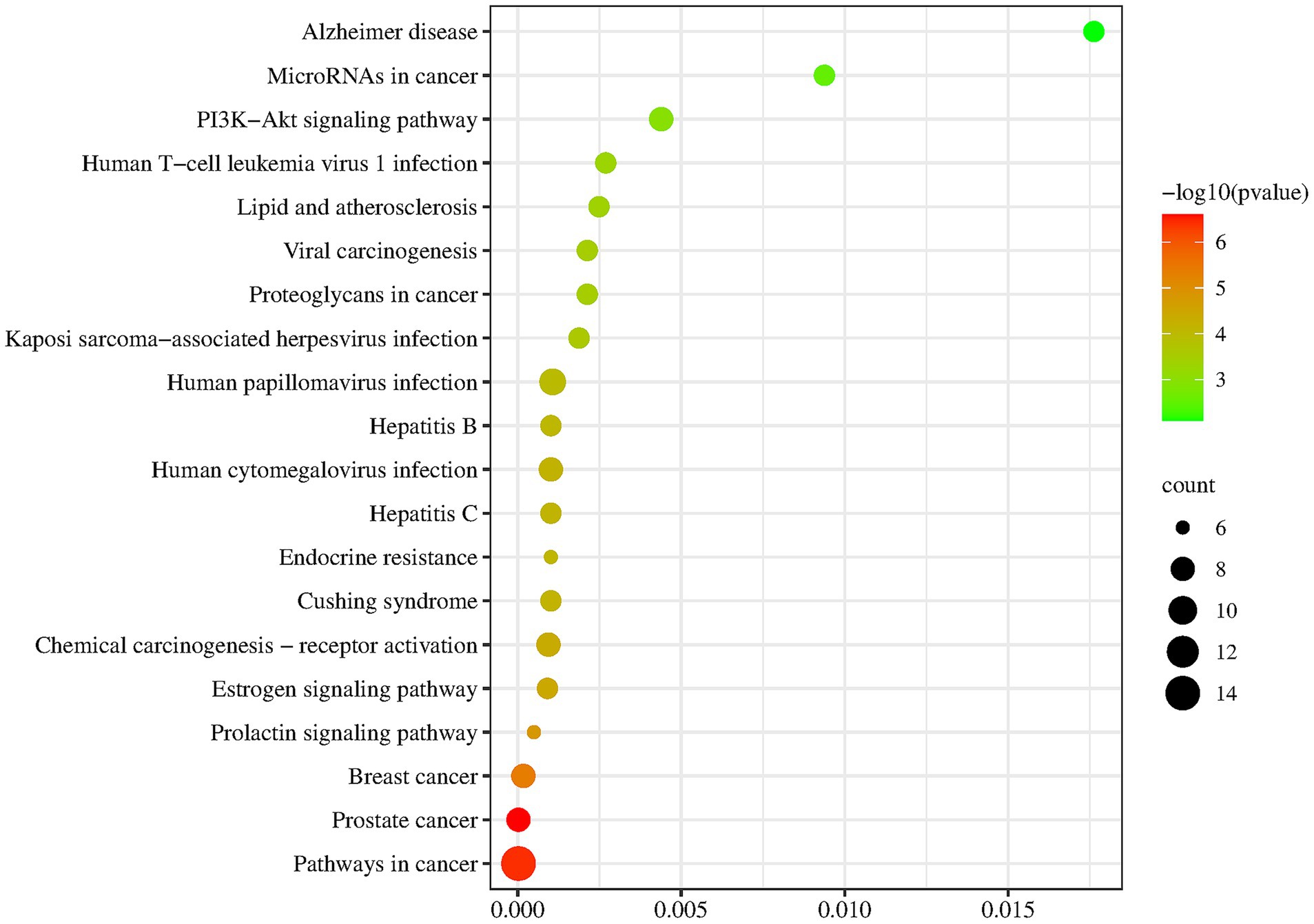
Figure 4. Enrichment results of key target protein KEGG. The larger the point was, the more relevant target points were; The redder the color, the higher the credibility.
3.6 Analysis of KEGG signaling pathways related to cardiovascular and cerebrovascularCardiovascular and cerebrovascular diseases based on atherosclerosis are the main killers threatening human health. Years of research showed that the common pathological basis of cardiovascular and cerebrovascular diseases comes from atherosclerosis, so the key to prevent cardiovascular and cerebrovascular diseases is to prevent atherosclerosis (15).
There are many factors affecting cardiovascular and cerebrovascular diseases, such as vascular endothelial growth factor A (VEGF-A), a dimer glycoprotein encoded by VEGF-A gene, which plays a crucial role in the process of inducing vascular growth (16). Many studies have also confirmed that Akt and downstream molecular activity changes are related to some cardiovascular diseases. Minamino et al. (17) detected a vascular endothelial cell senescence phenotype in atheromatous plaque tissue. The findings suggested that statins improved endothelial function and reduced myocardial remodeling in the early stages of myocardial infarction through activation of Akt. Yang Hui et al. (18) prepared a hyperlipidemia mouse model, treated the water extract of I. chinensis and injected it intraperitoneally. The study showed that I. chinensis has an important contribution to improving the antioxidant capacity of hyperlipidemia mice, and could reduce the level of lipid peroxidation, but the specific deep mechanism needs further study.
Signaling pathways are important for the study of diseases, based on the key targets in I. chinensis and cardiovascular diseases, KEGG enrichment analysis showed that lipids and atherosclerosis was more significant signaling pathways. Therefore, taking this pathway as an example, it is of great significance to explore the role of the key target in the signal pathway of I. chinensis, and to explore the specific mechanism of disease and treat disease.
3.6.1 Lipid and atherosclerosis signal pathwayThe elevated level of low density lipoprotein (LDL) cholesterol is a major risk factor for atherosclerosis. LDL can accumulate in the blood vessel wall and be modified by oxidation. Oxidized LDL (oxLDL) leads to endothelial dysfunction, the expression of adhesion molecules and the recruitment of monocytes in the subendothelial space (19). The extracellular oxLDL binds to the membrane receptor Lox-1. LOX-1 mediates the recognition and internalization of oxLDL, activates the substrate ROCK2, which inhibits PI3K, and then generates PIP3, thereby activating AKT, which promotes Bclxl phosphorylation, thus inducing cell apoptosis (20, 21).
Advanced glycosylation end products (AGEs) are harmful compounds formed by the combination of protein or fat in the blood with sugar. They bind with the RAGE receptor on the cell membrane, and then activate and generate ROS (22). ROS indirectly activates Src, which in turn activates Rac1. Rac1 further activates MKK4/7, promotes JNK phosphorylation, and then promotes AP-1 phosphorylation. The phosphorylated AP-1 will enter the nucleus, regulate DNA transcription, and affect the expression of MCP-1, ICAM-1, and IL-8, thus affecting the attachment and activation of downstream monocytes. ERK activated in cytoplasm can indirectly activate NF-κB, NF-κB affects the expression of MMP1,3,9 and TNF-α by promoting DNA transcription, thus affecting damage, cell apoptosis and inflammation (23).
Minimally modified low density lipoprotein (mmLDL) is LDL in which only the lipid fraction is oxidized and the lysine residue in the Apo B100 structure is not destroyed (24). MmLDL binds with TLR2/4/6 receptor on cell membrane to activate ERK, which in turn indirectly activates rap1, and rap1 activates Rac, which in turn activates NADPH oxidase, promotes the expression of ROS in vivo, and indirectly promotes NF-κB. In addition, mmLDL promotes the separation of intracytoplasmic phosphorylated IκBα from NF-κB through a series of pathways, and the separated NF-κB promotes DNA transcription, thus affecting the expression of MMP1,3,9 and TNF-α, which have effects on monocyte attachment and activation, injury and apoptosis, and inflammatory response.
Tumor necrosis factor (TNF-α) is a cytokine involved in systemic inflammation, and also one of the many cytokines that cause acute response. Extracellular TNF-α binds to the TNF-R1 receptor on the cytomembrane, indirectly activating CASP8, and then activating CASP3, thereby affecting cell apoptosis and plaque instability (25).
Very low density lipoprotein(VLDL)is a kind of lipoprotein which is composed of apolipoprotein synthesized in the liver by using the intermediate metabolites of chyle granules, bile acid, fatty acid, sugar and protein. VLDL binds to VLDLR receptor on the cell membrane, activates substrate PI3K, connects with PI3K-AKT signal, promotes the expression of PIP3, and then activates AKT (26). AKT phosphorylates GSK3β, and the phosphorylated GSK3β phosphorylates NFAT, which promotes DNA transcription and has an effect on cell proliferation (27).
The signal pathways are complex, and the proteins related to the key targets in the I. chinensis were all marked red (Figure 5), such as Src, TNFα, ERK, AKT, CYP, etc. It could be seen from the figure that most of the proteins in this pathway were distributed in the middle reaches, and they had important effects on inflammatory reaction, foam cell formation, cytokines, inflammatory signals, plaque instability, etc. The study of this pathway is helpful for anti atherosclerosis.
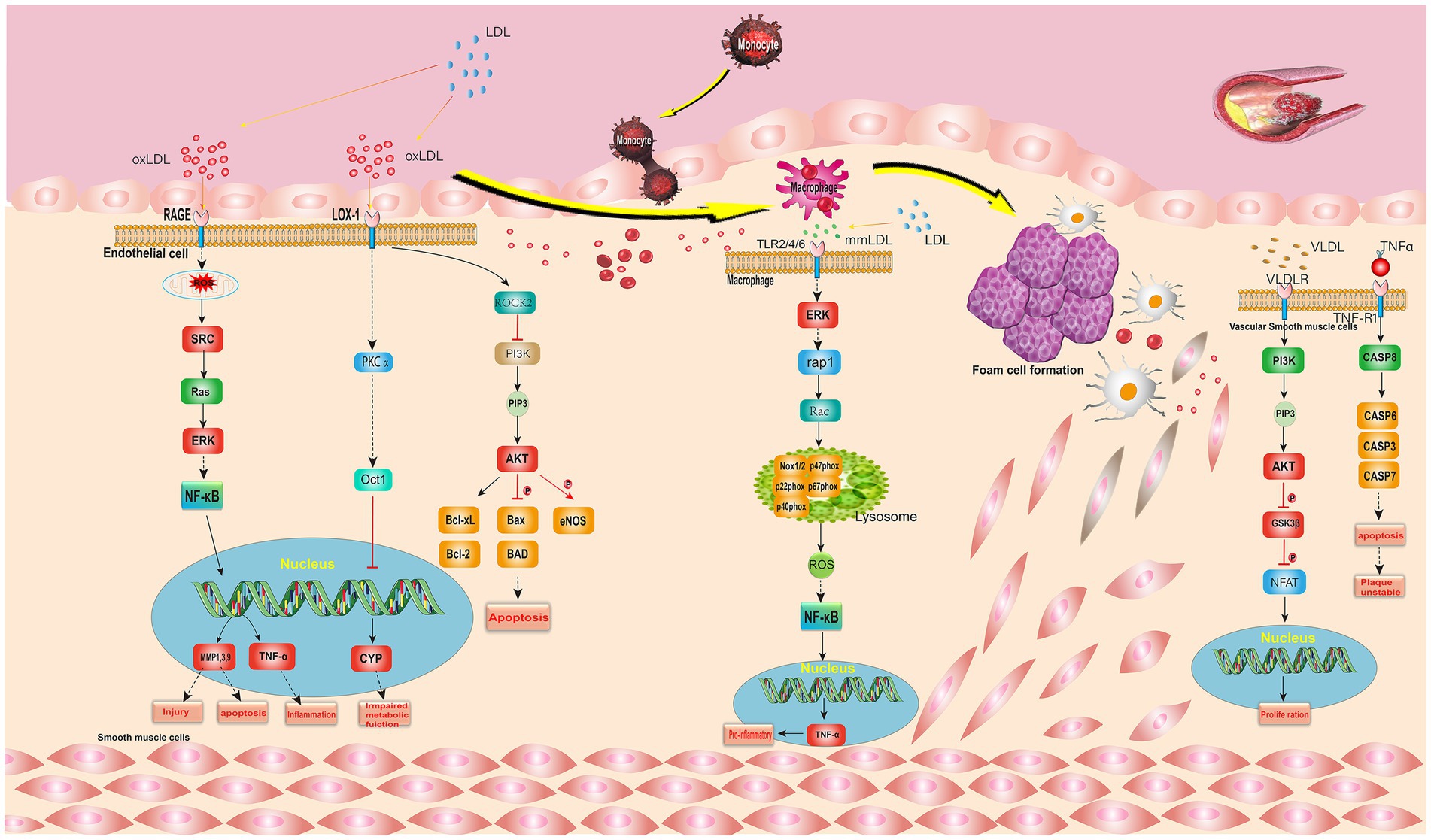
Figure 5. Lipid and atherosclerosis signal pathway. The gene marked red is the key target in I. chinensis.
3.7 Analysis of related diseases enriched by targetsDO data analysis was performed using Rstudio software, setting p-value <0.05 and Q value = 1. Disease enrichment analysis was performed on the key targets of I. chinensis action, removing the same diseases, and then extracting the 20 diseases with the highest number of targets and visualizing them using the Microbiology website (Figure 6 and Table 7). The main diseases included autosomal dominant disease, hereditary breast ovarian cancer, cell type benign neoplasm, female reproductive organ cancer, adenoma, biliary tract cancer, brain disease, diarrhea, renal cell carcinoma, atherosclerosis, arteriosclerotic cardiovascular disease, leiomyoma, osteoporosis, Alzheimer’s disease, tauopathy, bone cancer, connective tissue cancer, lymphoblastic leukemia, obesity, infertility, etc. The key targets proved to be highly relevant to these diseases. In order to explore the association between I. chinensis and diseases, Cytoscape 3.9.1 software was used to construct and visualize the “component-target-disease” network map using collected components, targets and disease data (Figure 7). The network consisted of 12 components, 238 targets and 20 diseases, which visually showed that multiple targets contained in one component could participate in the regulation of multiple diseases at the same time.
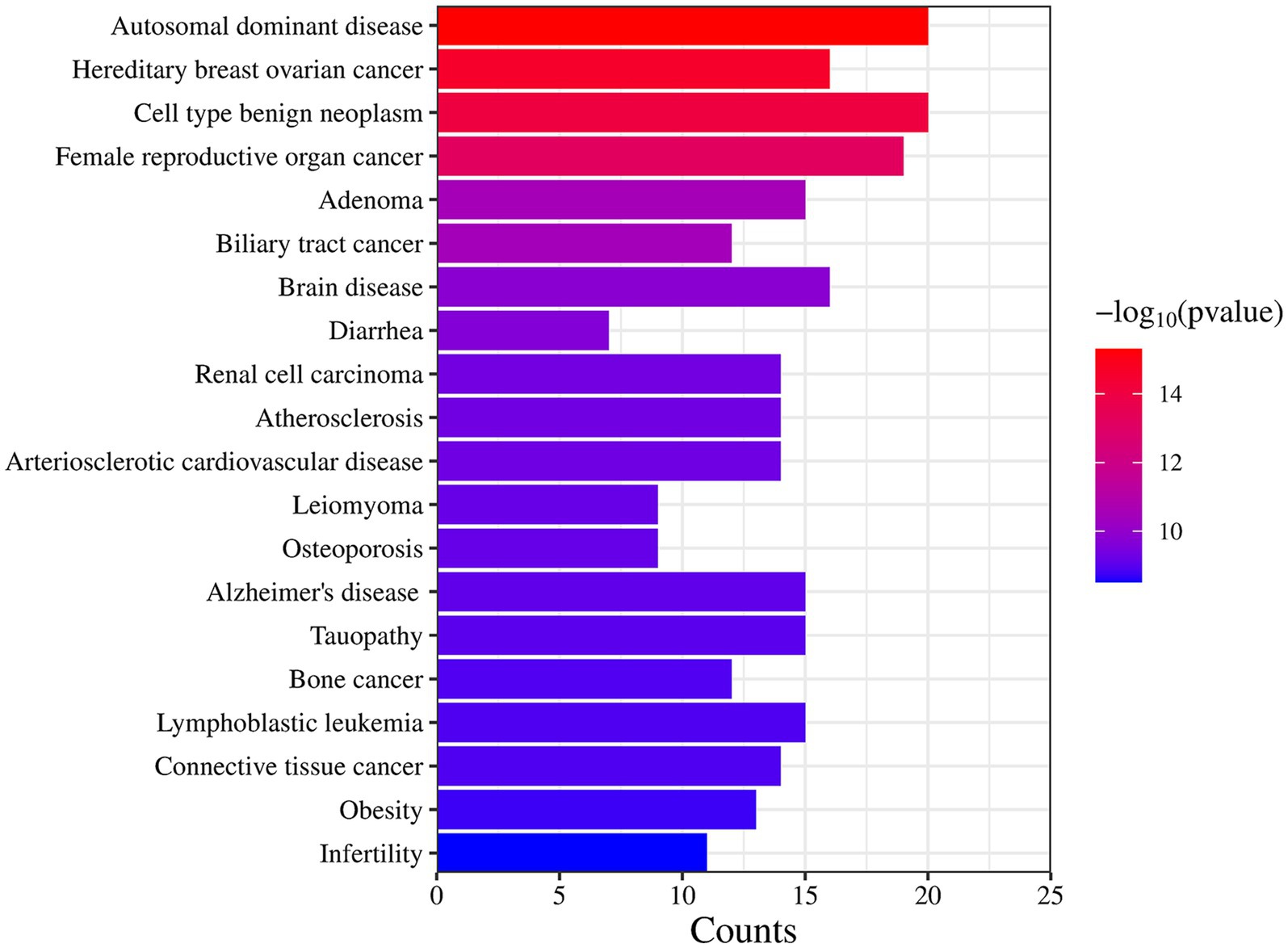
Figure 6. DO enrichment results for key target proteins. The longer the bar graph was, the more relevant targets were; The redder the color, the higher the credibility.

Table 7. DO enrichment results of key target protein.

Figure 7. Ixeris chinensis component-disease-target map. In the figure, the left circle represented active chemical components, the middle square matrix represented target genes, and the right circle represented diseases.
3.8 Molecular docking technique to predict the binding ability of the active components and key targets of I. chinensisMolecular docking technology is of great significance for further research in plant chemistry and biology (28). The current study docked each of the 7 active ingredients in I. chinensis with 10 key targets, yielding 70 docking results (Figure 8). The results revealed that luteolin, apigenin, chinensiolide c, chinensiolide b, chinensiolide a, β-sitosterol, and luteolin-7-O-β-D-glucoside had better docking ability with EGFR, ESR1, PTGS2, MAPK1, MMP9, and AR. The lower the binding energy, the better the molecule’s ability to bind to the protein (Table 8). Among them, MMP9 showed strong docking ability with each active ingredient, and β-sitosterol also showed strong binding ability with each protein. The docking results of the top 8 components with strong binding activity (binding energy ≤ −7 kcal·mol-1) to the targets were visualized and presented using PyMOL software (Figure 9). β-sitosterol forms one hydrogen bond with MMP9 via amino acid residue GLU-111, one hydrogen bond with PTGS2 via amino acid residue ARG-44, two hydrogen bonds with AR via amino acid residues GLN-802 and GLU-687, and one hydrogen bond with EGFR via amino acid residue GLU-758 forming one hydrogen bond; luteolin forming four hydrogen bonds with MMP9 via amino acid residues ALA-189, ALA-417, GLU-402, and LEU-188; apigenin forming three hydrogen bonds with MMP9 via amino acid residues ALA-189, ALA-417, and LEU-188, and three hydrogen bonds with MMP9 via amino acid residues ARG-752, ASN-705, GLN-711, and LEU-873 to form four hydrogen bonds with AR, and chinensiolide b to form three hydrogen bonds with PTGS2 via amino acid residues HIS-388, TRP-387, and TYR-385. The high binding energy between the main active components and key targets in I. chinensis indicated that I. chinensis might play its therapeutic role by regulating the above related targets.
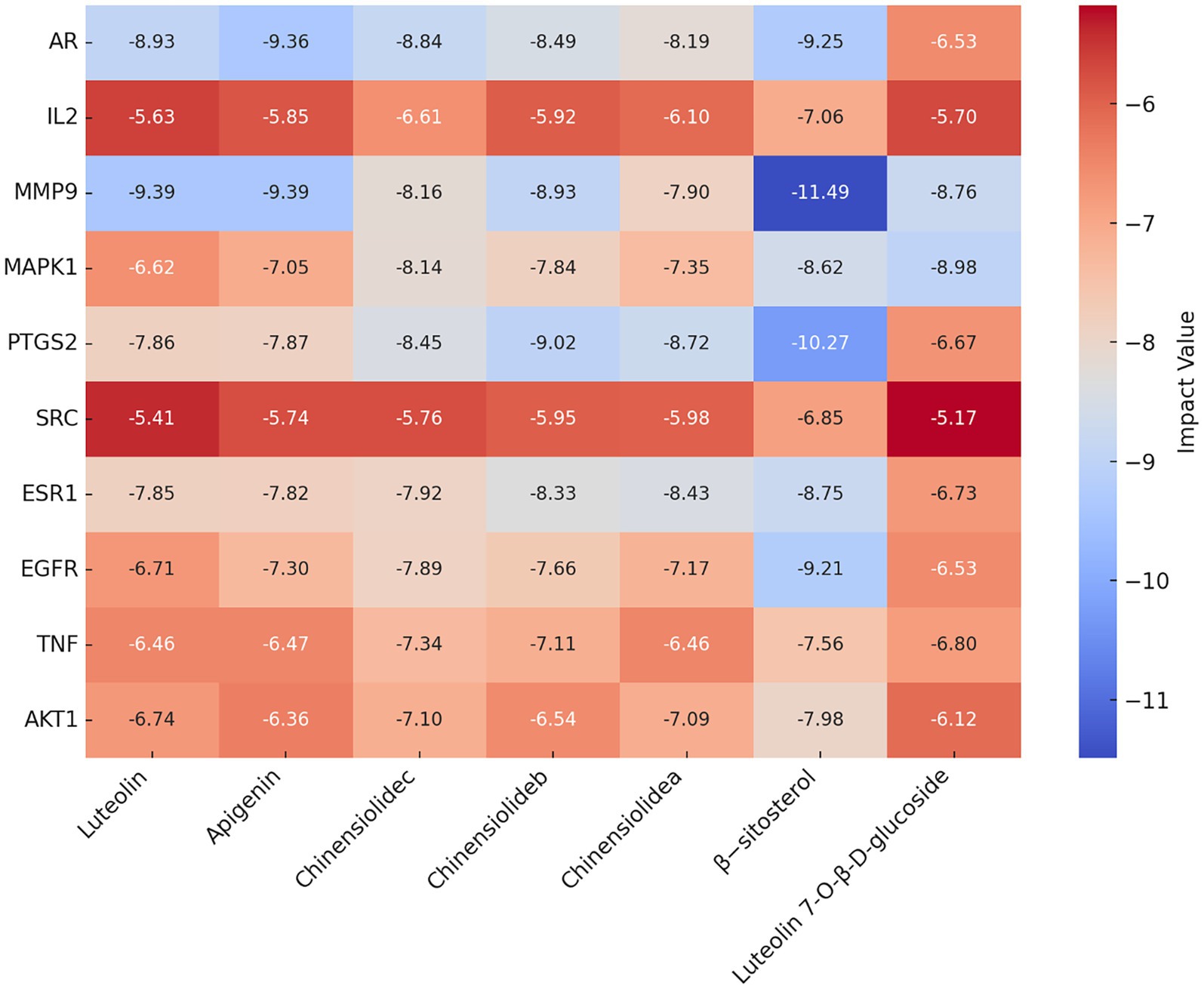
Figure 8. Docking and binding energy information of active ingredients and key target molecules in Ixeris chinensis. The redder the color, the better the binding ability.
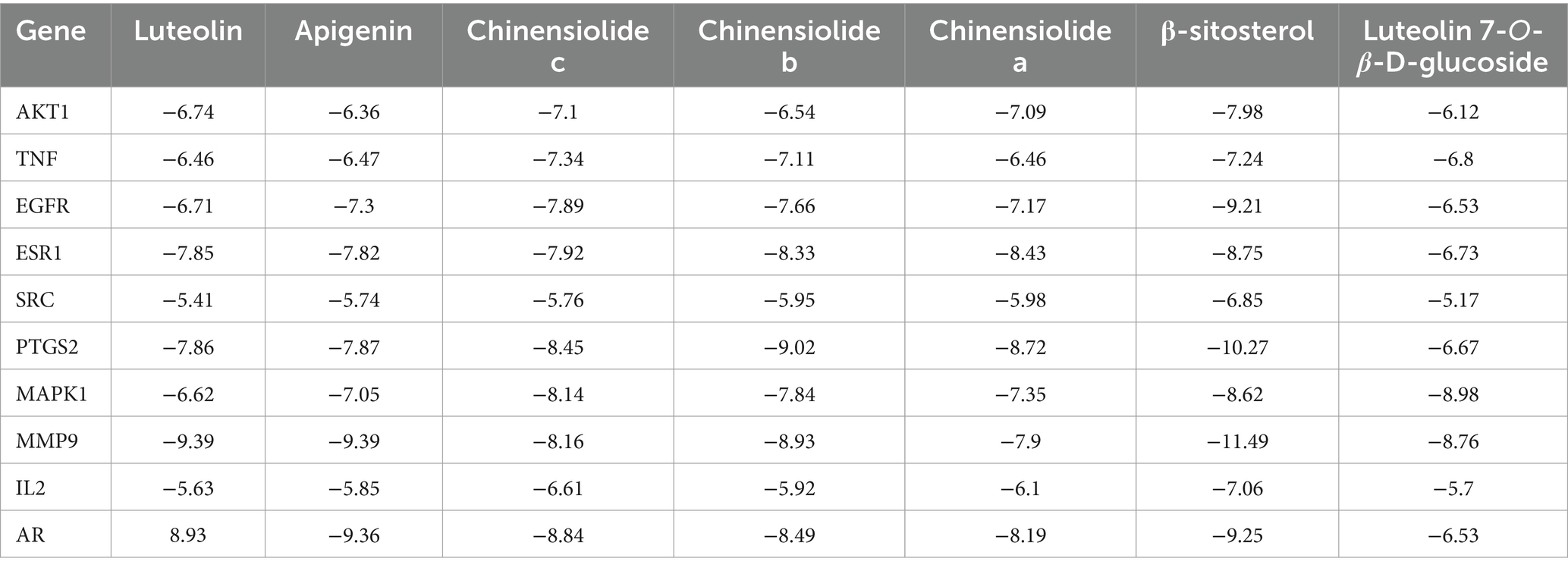
Table 8. The binding ability of the active components and key targets of Ixeris chinensis.
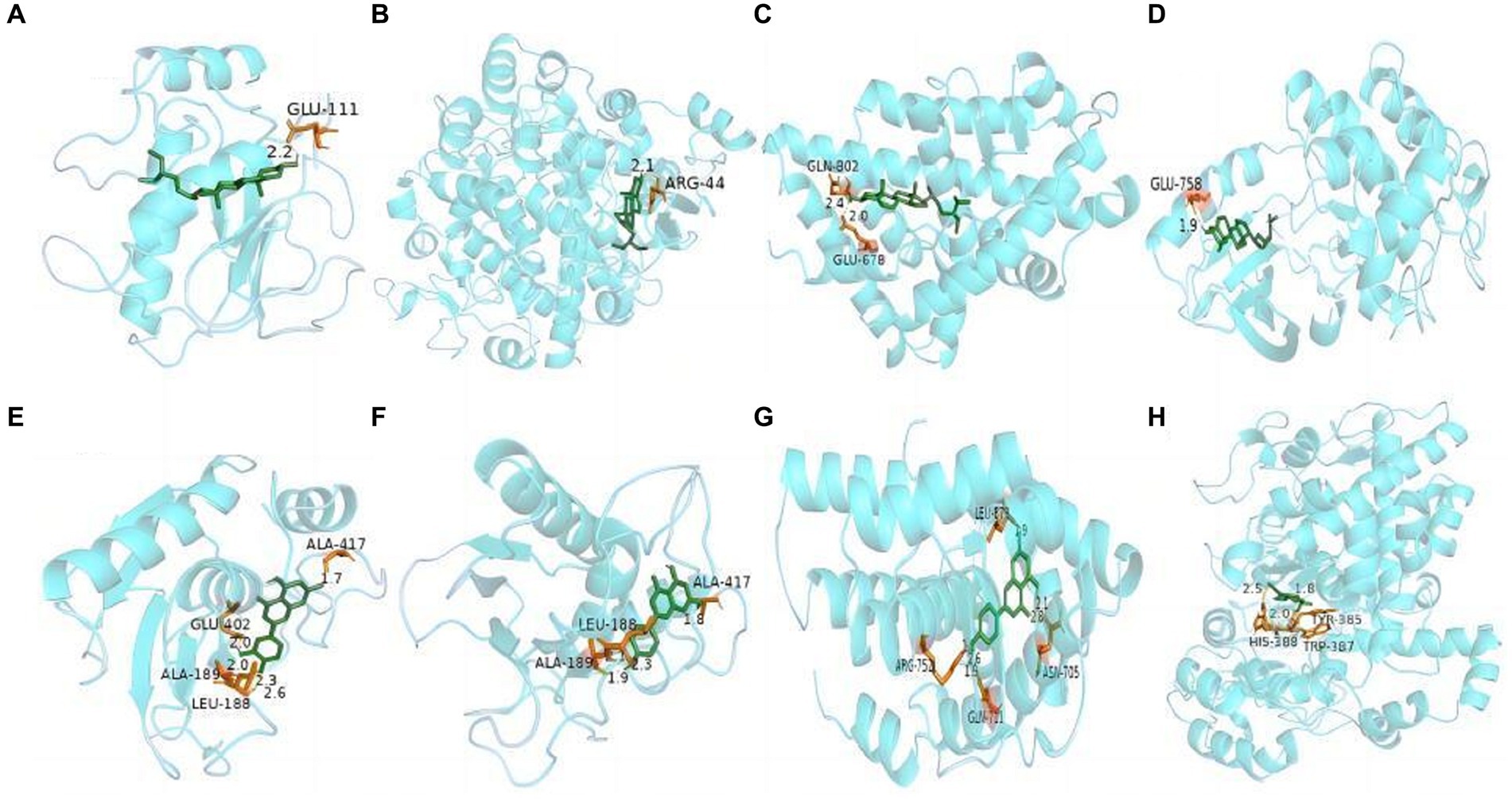
Figure 9. Docking analysis of the active components and key targets of I. chinensis. In the figure, the blue macromolecule is the target protein, and the green smaller molecule is the active component. (A) β-sitosterol and MMP9, (B) β-sitosterol and PTGS2, (C) β-sitosterol and AR, (D) β-sitosterol and EGFR, (E) luteolin and MMP9, (F) apigenin and MMP9, (G) apigenin and AR, (H) chinensiolide b and PTGS2.
3.9 Meta analysis results 3.9.1 Literature search and screening resultsThe document screening process and basic characteristics of included documents are shown in the figure below (Figure 10 and Table 8). A total of five randomized controlled trials (RCTs) were conducted, including studies employing Sprague–Dawley (SD) rats, ICR mice, C57BL/6J mice, Wistar rats, and KM mice. For modeling, one study was fed with high-fat and high-sugar diets, two studies used carbon tetrachloride (CCl4), and two studies were fed with high-fat diets. The interventions were mainly treated with I. chinensis water extract. The diseases included in the studies mainly consisted of two cases of lipid-based diseases and three cases of hepatitis-based diseases. The included outcome indicators contained TC, TG, HDL-C, LDL-C, and MDA.
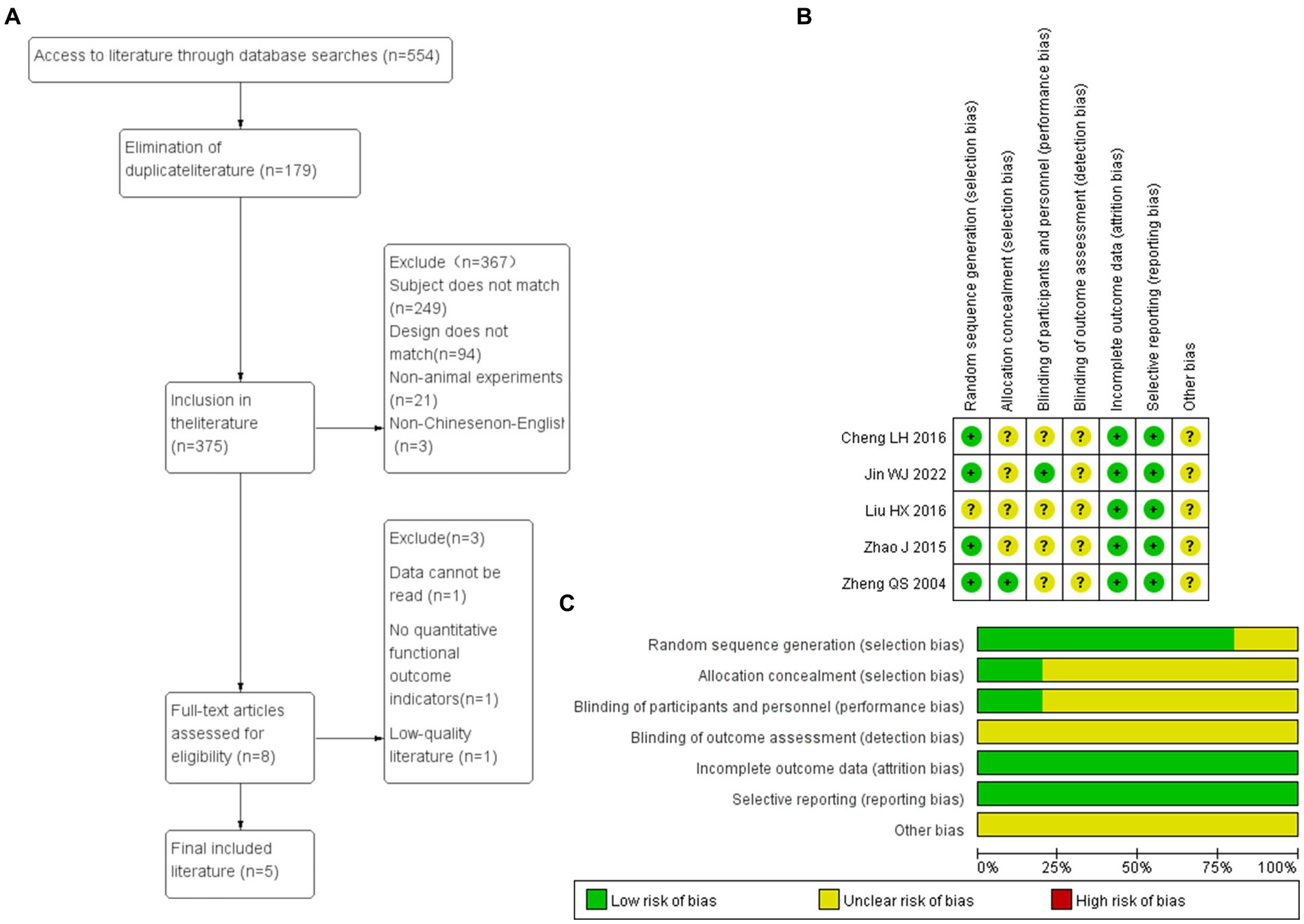
Figure 10. (A) Flow chart of document screening. (B,C) Risk assessment of literature bias. Green is low risk bias, yellow is unknown risk bias, and red is high risk bias. The length of the bar indicates the proportion of this bias in the total number of articles.
3.9.2 Document quality evaluationThe five research baselines included were comparable. In the Random sequence generation, four studies described the random allocation method in detail and were rated as low risk bias, while one study only mentioned the word “random” without specifying the specific method and was rated as unknown risk bias. In the Allocation consideration, only one described the allocation concealment scheme, which was rated as low risk bias, and the rest as unknown risk bias. Among Blinding, only one described the allocation concealment scheme, which was rated as low risk bias, and the rest as unknown risk bias. In the Incomplete outcome data, all studies reported complete results and were rated as low risk bias; In selective reporting, none of the five studies reported selectively, which was rated as low risk bias. In Other bias, five studies were unable to judge whether there were other sources of bias, and all were rated as unknown risk bias (Figure 10).
3.9.3 Statistical analysis resultsIncluded in the study, three articles reported four changes in blood lipids (29–31) (Figure 11A). The above three articles were divided into four subgroups according to blood lipid indicators. Heterogeneity between studies (I2 > 50%) was analyzed by random effect model. Meta analysis results showed that I. chinensis could significantly reduce the blood TC level, [SMD = –1.85, 95% CI (−2.87, −0.38), I2 = 53%, p = 0.0004], indicating significant heterogeneity and statistically significant difference. I. chinensis could also significantly reduce the blood TG level, [SMD = –1.95, 95% CI (−3.02, −0.87), I2 = 51%, p = 0.0004], indicating significant heterogeneity and statistically significant difference. I. chinensis showed no statistically significant difference in improving HDL-C [SMD = 1.34, 95% CI (0.26, 2.42), I2 = 65%, p = 0.02]. I. chinensis significantly reduced blood LDL-C levels, [SMD = –2.77, 95% CI (−3.87, −1.66), I2 = 43%, p < 0.00001], suggesting that the difference was statistically significant. The sensitivity analysis of the included literatures was carried out one by one with the method of exclusion. None of the literatures had a great impact on the results of this Meta-analysis, which meant that this study has a good stability.
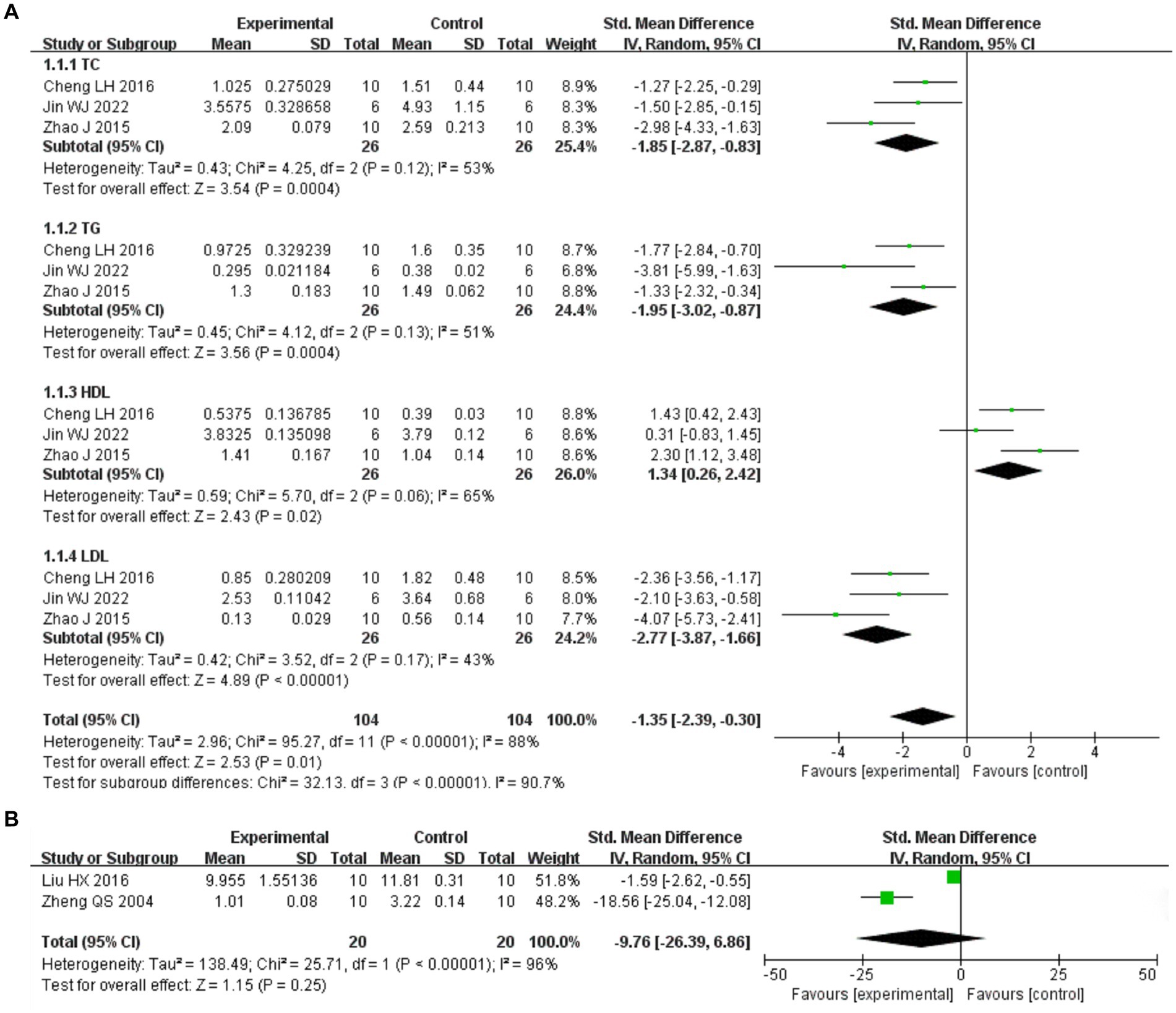
Figure 11. The study was grouped according to outcome indicators. The random effect model was used for analysis. Heterogeneity was calculated using I2. The summary estimates of the standard mean difference and 95% confidence zone were calculated using Review Manager 5.4.1. (A) Take the four items of blood lipid as the outcome index. (B) Take MDA as the outcome indicator.
Among the included studies, two articles reported changes in MDA with heterogeneity between studies (I2 > 50%), analyzed using a random-effects model (32, 33) (Figure 11B). The difference in I. chinensis in improving HDL-C was not statistically significant [SMD = −9.76, 95% CI (−26.39, 6.86), I2 = 96%, p = 0.25].
3.9.4 Publication bias analysisWe used the four indicators of blood lipids as an example to create a funnel plot. Funnel diagram showed that the included articles were asymmetric with the symmetry axis as the boundary, indicating that there was publication bias, which might be related to the small sample size of the included articles (Figure 12).
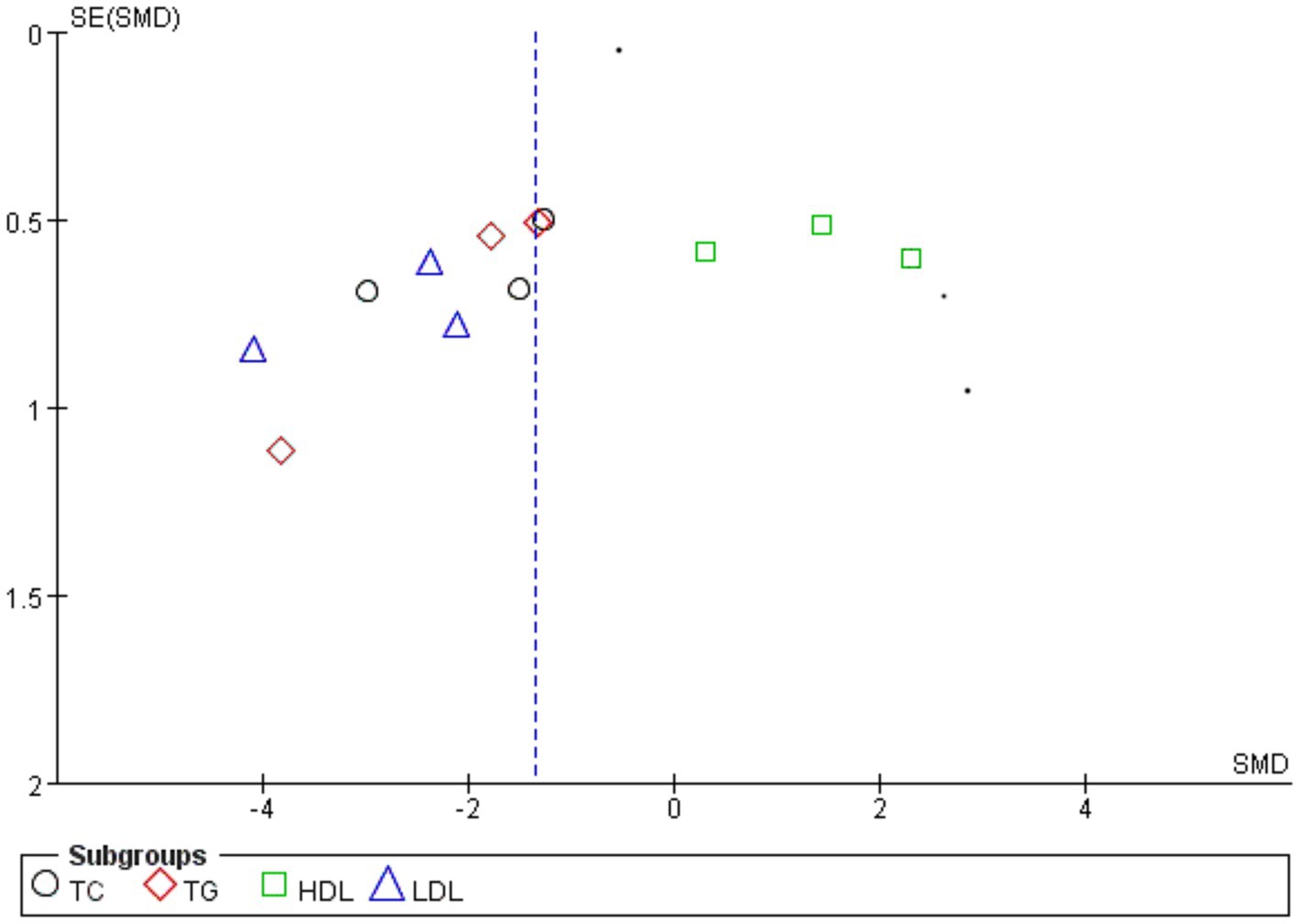
Figure 12. Funnel chart analysis of publication bias with four blood lipids as outcome indicators.
4 DiscussionAs a traditional Chinese herbal medicine, I. chinensis has complex types and various functions. It has been used as a medicinal material for lowering blood glucose, cholesterol, diuresis, bloodpressure, anticoagulation, liver protection, antiinflammatory, antibacterial, anti-tumor and so on (6). The emergence of traditional.
Chinese medicine network pharmacology provides an opportunity to systematically explore the molecular complexity of traditional Chinese medicine prescriptions and the molecular relationship between traditional Chinese medicine ingredients and complex diseases (34). In recent years, the pharmacological effects of I. chinensis have been widely studied, but the specific mechanism of disease action is still unclear and needs to be further studied. Therefore, we should start from the analysis of active components to explore the key role targets of I. chinensis, and carry out GO and KEGG analysis, conduct molecular docking which is of great significance to predict the biological process, cell composition, molecular function and signal pathway of I. chinensis, and h
留言 (0)